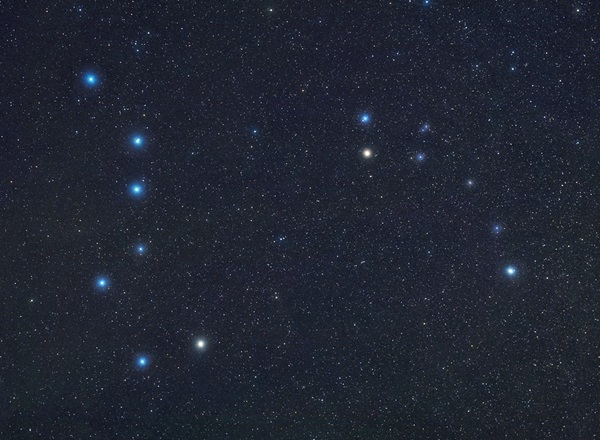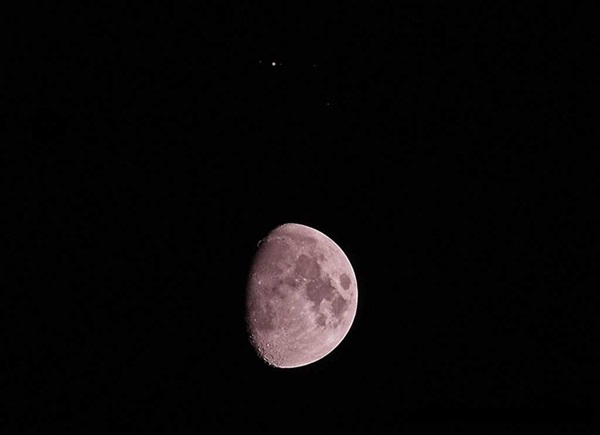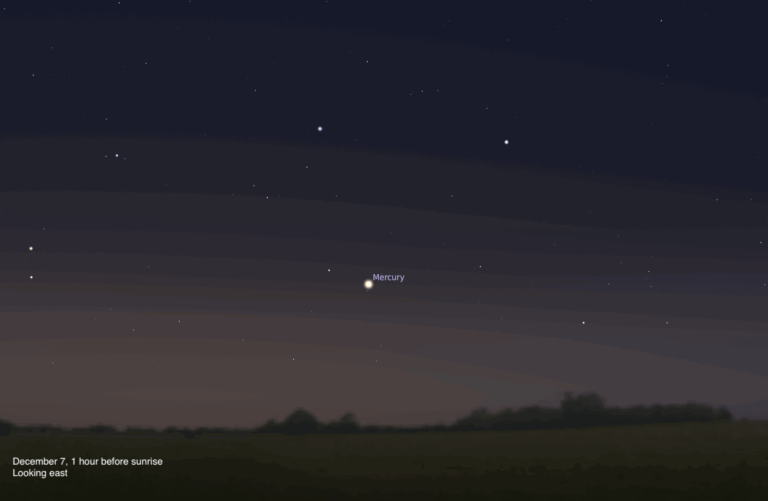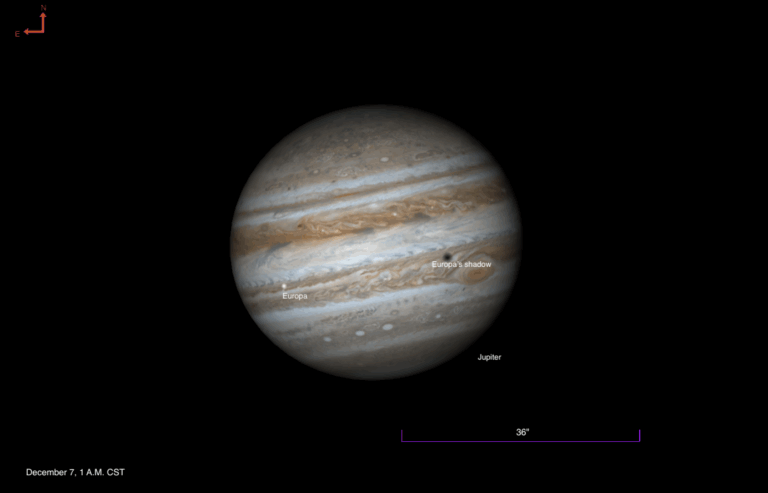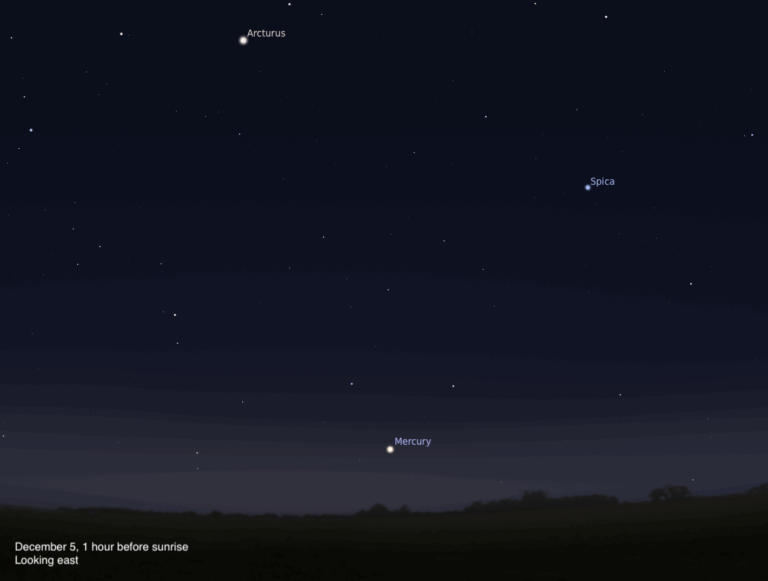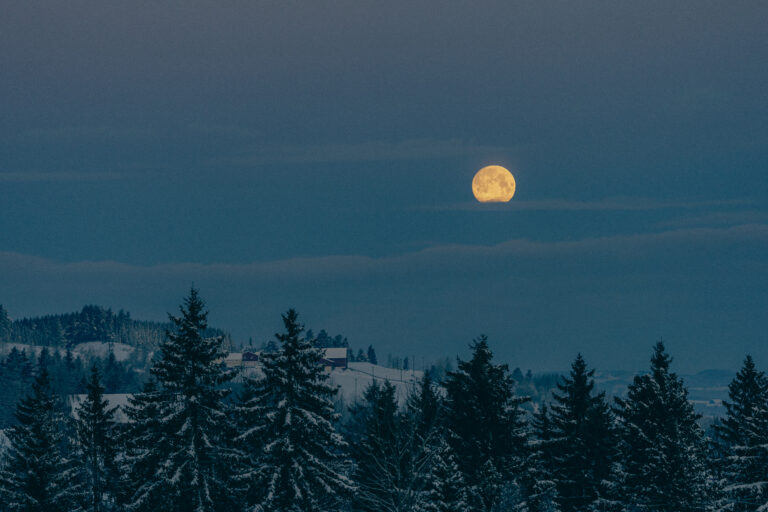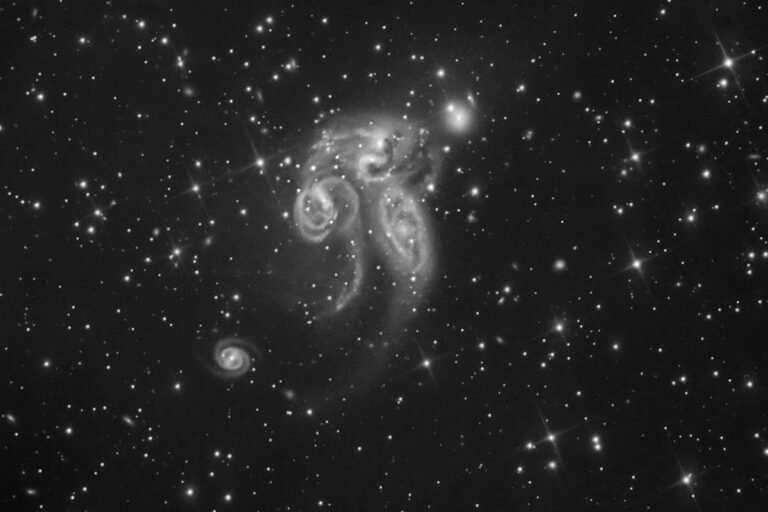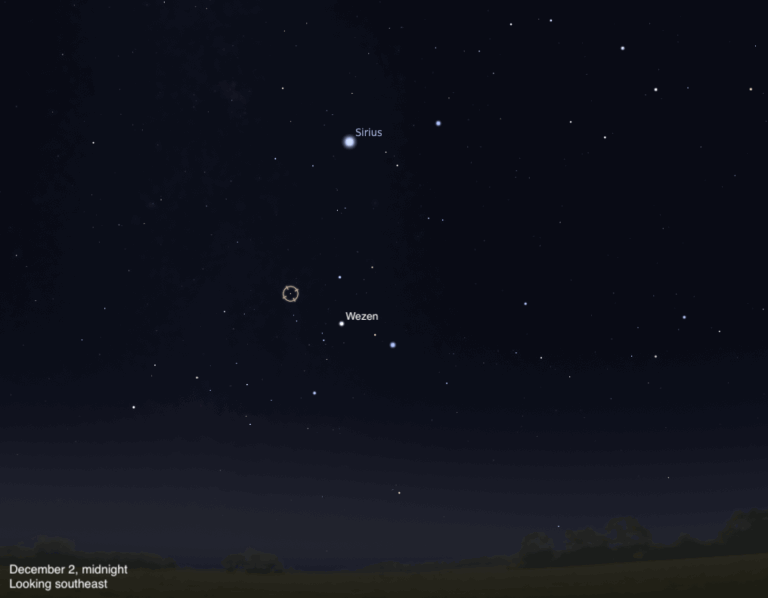Key Takeaways:
The Summer Triangle asterism dominates the eastern sky in late evening. Vega, the triangle’s brightest member, shines at magnitude 0.0 and stands highest of the three stars. To its lower left lies Deneb; at magnitude 1.3, it’s the faintest of the trio. Magnitude 0.8 Altair completes the bright asterism once it rises shortly before 11 p.m. local daylight time. Despite its name, the Summer Triangle appears prominent from late spring until the onset of winter.
Saturday, May 18
Full Moon occurs at 5:11 p.m. EDT, and our satellite looks completely illuminated all night. You can find it low in the southeast as darkness falls and peaking in the south around 1 a.m. local daylight time. The Moon begins the evening among the background stars of eastern Libra the Scales, but it crosses into northern Scorpius the Scorpion shortly before midnight across eastern North America and a bit after midnight from the continent’s western half.
Venus pokes above the eastern horizon about an hour before the Sun rises. The brilliant planet shines at magnitude –3.8 and dominates the predawn sky as twilight brightens. When viewed through a telescope, the inner world shows a disk that spans 11″ and appears 92 percent lit. You wouldn’t know it from a quick glance with the naked eye, but there’s a bonus object in Venus’ vicinity this morning. Look for 6th-magnitude Uranus 1.2° due north (to the upper left) of Venus. The distant planet should show up through 7×50 binoculars shortly after the pair rises if you have a clear sky and an unobstructed eastern horizon.
Sunday, May 19
Mars continues its eastward trek against the backdrop of western Gemini this week. Shining at magnitude 1.7, the Red Planet appears slightly fainter than the constellation’s brightest stars, Castor and Pollux. The ruddy world lies nearly 20° high in the west-northwest an hour after sundown and doesn’t set until nearly 11 p.m. local daylight time. And this evening, Mars skims less than 0.5° north of the 5th-magnitude star cluster M35. (It appeared slightly farther from this fine open cluster yesterday evening.) Binoculars or a telescope at low power will provide the best view of this pretty conjunction, especially once the sky grows dark around 10 p.m. local daylight time. The brightness disparity between the two objects is impressive: Mars appears nearly 25 times brighter than the combined glow from all the cluster’s distant suns. If you turn a telescope on the planet, you’ll see a featureless disk that spans only 4″.
The waning gibbous Moon stands about 7° east of Jupiter this evening. The giant planet rises shortly before 10 p.m. local daylight time, about 20 minutes before the Moon. The two march in tandem across the night sky until morning twilight drowns them out. The two objects were a similar distance apart yesterday, though the Moon was then west of the planet.
Tuesday, May 21
Neptune rises around 3 a.m. local daylight time and appears nearly 15° high in the east-southeast as twilight commences. The distant world glows at magnitude 7.9, so you’ll need binoculars or a telescope to spot it. Fortunately, it lies near a brighter star that will guide you. This morning, Neptune stands 1.1° east-northeast of 4th-magnitude Phi (φ) Aquarii. You can confirm your sighting of Neptune through a telescope, which reveals the planet’s 2.3″-diameter disk and blue-gray color.
Mercury reaches superior conjunction at 9 a.m. EDT. This means the innermost planet lies on the opposite side of the Sun from Earth and remains hidden in our star’s glare. It will return to view in the evening sky at the end of May.
Wednesday, May 22
The Moon shifts an average of 13° eastward relative to the background stars every day, and this motion carries it near Saturn tonight. The ringed planet rises shortly after 11:30 p.m. local daylight time, 20 minutes before the waning gibbous Moon. The two then cross the morning sky together, with Luna trailing some 5° behind its planetary companion. Not surprisingly, the Moon appears far brighter than the magnitude 0.3 planet. But Saturn stands out when the Moon is not nearby, shining four times brighter than any of the background stars in its host constellation, Sagittarius the Archer. A telescope shows the gas giant’s 18″-diameter disk and a spectacular ring system that spans 40″ and tilts 24° to our line of sight.
Thursday, May 23
With the Moon having exited the evening sky, now’s a good time to target one of the spring sky’s finest deep-sky objects. The Beehive star cluster (M44) in the constellation Cancer the Crab lies 30° high in the west after darkness falls. The 3rd-magnitude cluster appears approximately 40 percent of the way from 1st-magnitude Pollux in Gemini to the similarly bright star Regulus in Leo. With naked eyes under a dark sky, you should be able to spot the Beehive as a faint cloud. But this star group explodes into dozens of stars through binoculars or a small telescope at low power.
Head outside late this evening and you can’t miss Jupiter. The giant planet rises before 10 p.m. local daylight time and climbs highest in the south around 2 a.m. Jupiter shines at magnitude –2.6, which makes it the brightest point of light in the sky until Venus rises in morning twilight. The planet currently resides among the much dimmer background stars of the constellation Ophiuchus the Serpent-bearer. A telescope reveals dramatic cloud features on the gas giant’s 46″-diameter disk as well as the four bright Galilean satellites. And tonight provides a rare opportunity to see the solar system’s largest moon disappear. As Jupiter rises, Ganymede appears west of the planet. If you keep watching, however, you’ll see the moon slowly fade from view. At 1:41 a.m. EDT, Ganymede starts to enter Jupiter’s shadow while it’s still 16″ from the planet’s limb. The moon is so big that it takes 14 minutes to disappear completely.
Saturday, May 25
Look high in the north after darkness falls this week and you’ll be greeted by the familiar sight of the Big Dipper. The dipper is the sky’s most conspicuous asterism — a recognizable pattern of stars that doesn’t form a complete constellation shape. It forms the body and tail of Ursa Major the Great Bear. Use the Pointers, the two stars at the end of the dipper’s bowl, to find Polaris, which lies due north for everyone north of the equator. Polaris marks the end of the Little Dipper’s handle. On evenings in late May, the relatively faint stars of this dipper arc almost directly above Polaris.
Sunday, May 26
Last Quarter Moon occurs at 12:34 p.m. EDT. When it rises around 2:30 a.m. local daylight time tomorrow morning, it will appear slightly less than half-lit. Earth’s only natural satellite then appears against the background stars of Aquarius the Water-bearer.
Today also marks the Moon’s apogee, the farthest point in its orbit around Earth. At 9:27 a.m. EDT, it lies 251,119 miles (404,138 kilometers) from Earth’s center.

